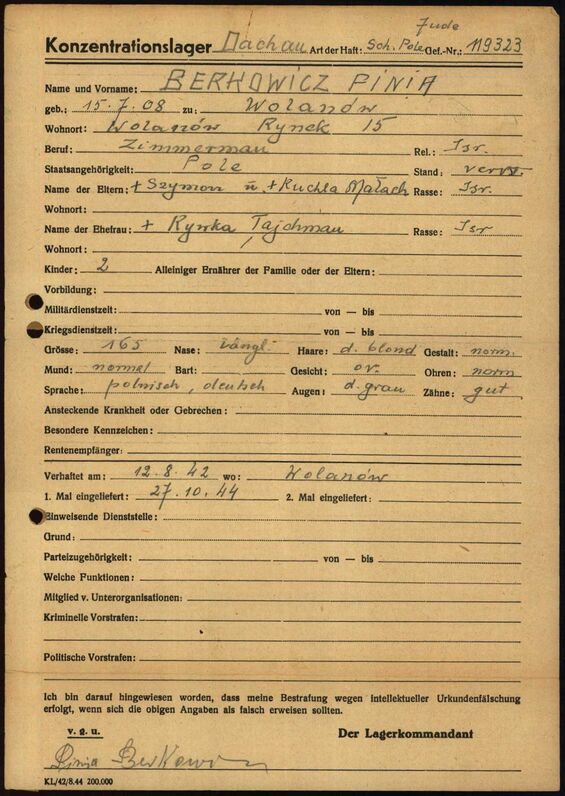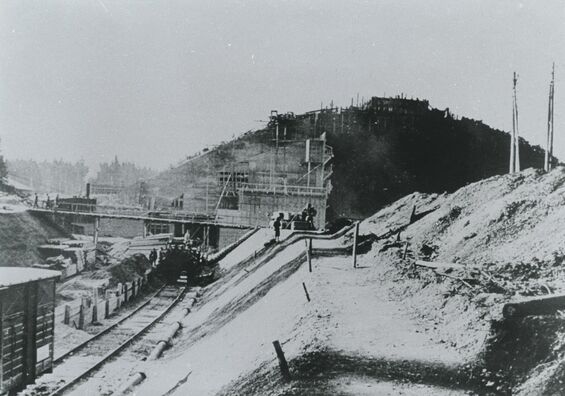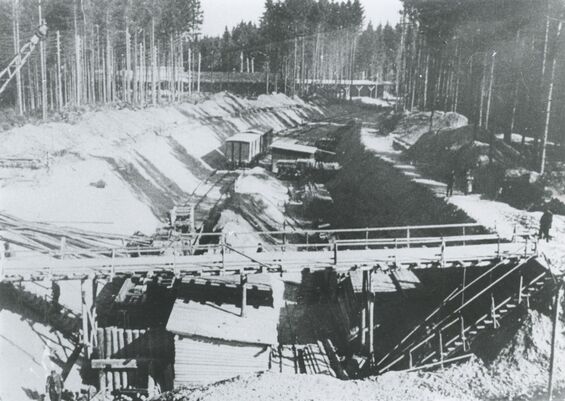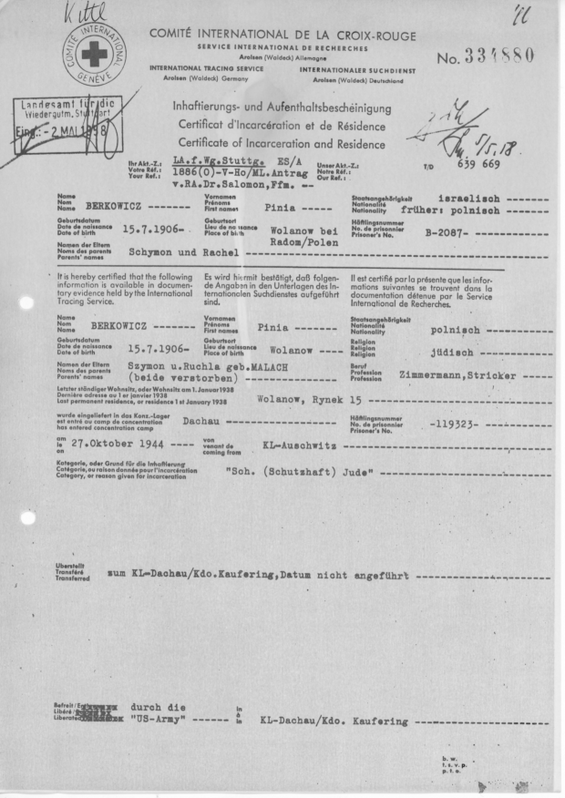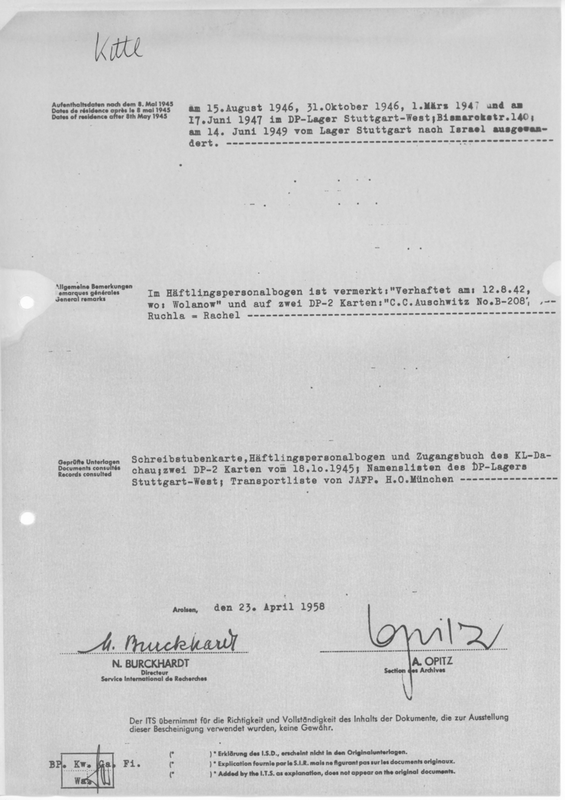The Biography of Pinia Berkowicz, Wolanow
Short biography and stations of his persecution
- born on 15 July 1906 in Wolanow, died on 14.1.1978, owner of a textile store in Wolanow
- 1939 expropriation
- 12 August 1942 arrested in Wolanow
- Lublin-Majdanek concentration camp/Blizyn subcamp, work in the quarry
- Auschwitz concentration camp, prisoner number B-2087(?)
- 27 October 1944 Dachau concentration camp, prisoner number 119323
- Dachau concentration camp / Kaufering subcamp, work for the Moll company
- 1946 to 1949 Displaced Persons Camp Stuttgart-West
- 9 June 1949 Israel
- 26 March 1958 USA
Pinia Berkowicz lost his father, his wife, two brothers and his two children to persecution. He was 33 years old when his persecution began.
Before the War
I am making this affidavit in connection with my application for compensation for damage to body and health. Before the outbreak of the Second World War, I lived with my family in Wolanow. I had married for the first time in 1929. My first wife's name was Rywka née Teichman and I had a daughter and a son - Esther born in 1934 and Berel in 1937. I was a strong, healthy, enterprising man. I had my own textile business and I earned a good living.
Source: Affidavit
until Juli/August 1943: Wolanow, Ghetto Wolanow
My ordeal began after the Nazis occupied my home town. My business was taken away from me as early as 1939. I was put to various forced labor tasks. I lived under oppressive conditions until 1942. As one of my brothers was a member of the Jewish community in Wolanow, I was arrested and taken to the prison in Wolanow. We were interrogated and told to reveal where the valuables were. Because it was suspected that people had hidden them. We were brutally beaten.
Source: Affidavit
I lived in constant fear of death and trembled for the lives of my small children and my wife, as children were the first to be killed. In 1942, a typhus epidemic broke out in the camp. I contracted typhus and was in a terrible condition. But the most terrible thing for me was that my beloved wife and two of my brothers died of typhus fever. My father and my children were killed in 1943.
Source: Affidavit
| Ghetto | |
|---|---|
| Place | Wolanów |
| Designation | |
| Area | Generalgouvernement, Distrikt Radom (1939-1945) |
| Opening | 01.07.1941 |
| Liquidation | 01.07.1942 |
| Deportations | ab 01.07.1942 |
| source: deutschland-ein-denkmal.de | |
The claimant was born in 1906 in Wolanow, Poland. He ran a textile business until 1939, when the Germans came. Then he had to do forced labor at the airfield. In 1940 he was sent to ZAL Wolanow. He lived in wooden barracks and still had enough food. The forced labor he continued to perform at the airfield still consisted of construction work.
Source: Landesarchiv-Baden-Württemberg, Abt. Staatsarchiv Ludwigsburg, EL 350 I Bü32700, expert opinion dated 13.12.1966
| Forced labor camps for Jews in the "Generalgouvernement" | |
|---|---|
| Place | Wolanów |
| Area | General[gouvernement, Radom district (1939-1945) |
| Opening | 1940 |
| Closing | July/August 1943 |
| Deportations | The prisoners were "transferred" to the forced labor camps for Jews in Radom, Blizyn and Starachowice |
| Prisons | |
| Gender | Men |
| Employment of the prisoners at | Company Kuhlmann, Hanover; Company Wilhelm Hölscher; Hanover; Company Jünicke (or Jenicke), construction company; NSKK (NationalSocialist Motorcycle Corps), Kommandantur; Hegent & Höner, Hamburg; Company vonder Wetter |
| Type of work | Construction work, work on the airfield, painting and decorating work |
| Source: deutschland-ein-denkmal.de | |
Blizyn
I myself was dragged to the Blizin concentration camp. Here I had to do extremely hard forced labor in the quarry. We were constantly beaten at work.
Source: Affidavit
In the summer of 1943, he was sent to ZAL Blizin. He had to work here for a year in the quarry [...] There was little to eat and he lived with his two children in wooden barracks. His wife had died in Wolanow. The claimant states that his two children also perished in Blizin.
| Subcamp of the Lublin-Majdanek concentration camp, subcamp of Radom | |
|---|---|
| Location | Bliżyn |
| Name | |
| Area | General Government, Radom District (1939-1945) |
| Opening | February 1944, previously a forced labor camp for Jews |
| Closing | "Evacuation" on 30.07.1944 to Auschwitz concentration camp. On October 9, 1944, the subcamp is still mentioned with 15 prisoners |
| Deportations | |
| Prisons | |
| Gender | Men |
| Employment of the prisoners at | SS-WVHA/Amt W IV/1 Deutsche Ausrüstungswerke GmbH; SS-WVHA/Amt W I/2 Deutsche Erd- und Steinwerke GmbH |
| Type of work | Work in the quarry; work in the munitions factory |
| Source: deutschland-ein-denkmal.de | |
Auschwitz, Dachau, Landsberg
In the summer of 1944, he was sent to Auschwitz concentration camp. In Auschwitz he also had to work hard until the fall of 1944, tearing down barracks, building new barracks, digging trenches and other work. He lived in barracks again.
In the fall of 1944, he was sent to Landsberg concentration camp. He had to sleep in pits in the ground. He was exposed to the weather, rain, snow and cold without sufficient clothing.
He wore concentration camp clothing and made footwear out of cement sacks. He had to work hard in the forest, digging concrete trenches. [...] Once, when he collapsed in pain - he had to carry a sack of cement - an SS man kicked and punched him to get him up again. On May 1, 1945, he was driven to Buchberg. He was here for about 2 days when he was liberated by the Americans.
Source: Landesarchiv-Baden-Württemberg, Abt. Staatsarchiv Ludwigsburg, EL 350 I Bü32700, expert opinion dated 13.12.1966
Then I was sent to the Auschwitz extermination camp. Here they tattooed me with the number B 2087. I stayed in the DP camp until October and was then driven to the Dachau concentration camp, to the Landsberg satellite camp. Although I was only a shadow of a human being, I had to do forced labor at the MOLL company. I was liberated on the so-called death march.
Nach dem Krieg
When I was liberated, I was just a shadow of a person. I immediately received medical treatment. As far as I remember, it was doctors from the US Army who looked after me. I then settled in Stuttgart. I also received medical treatment here, but I can't remember any of the doctors today.
Source: Affidavit

